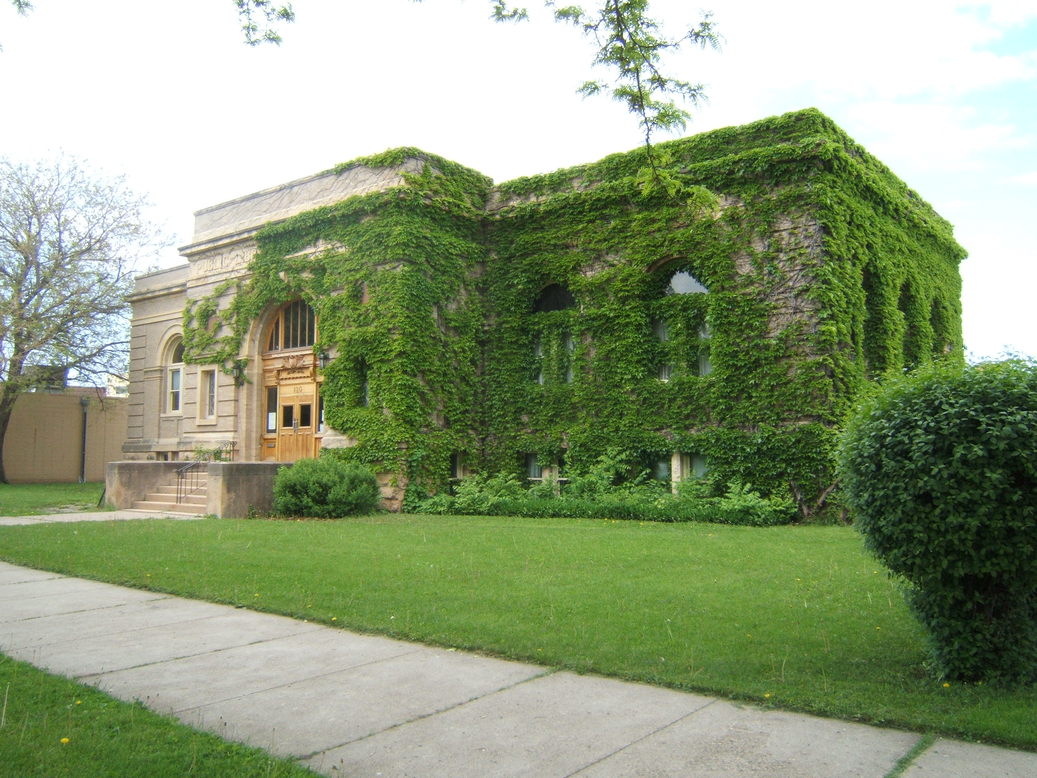 |
| The Mankato Carnegie Library looking like it might have on the snowy day Betsy first visited it. {Source} |
The small white marble temple was glittering with newness. Betsy went up the immaculate steps, pulled open the shining door.with a big cage in the center, a cage such as they had in the bank, with windows in it. Behind rose an orderly forest of bookcases, tall and dark, with aisles between them.Betsy advanced to the cage and the young lady sitting inside smiled at her. (Betsy and Tacy Go Downtown, 560).
This quote from the fourth Betsy-Tacy book describes Betsy's first visit at Deep Valley's brand new Carnegie Library, which Mr. Ray introduced us to a few pages earlier:
This desk in the in the library today looks
similar to the one Lois Lenski drew (see
above left image). {Source}"But if you're going to be a writer," he went on, "you've go to read. Good books. Great books. The classics. And fortunately ... that's what I'm driving at ... Deep Valley has a new Carnegie Library, almost ready to open. White marble building, sunny, spick and span, just full of books.""I know," Betsy said."That library," her father continued, "is going to be just what you need. And your mother and I want you to get acquainted with it. Of course it's way downtown, but you're old enough now to go downtown alone." (Betsy and Tacy Go Downtown, 555)
Here is a little background on the Mankato Carnegie Library:
The Mankato Public Library and Reading Room, now known as the Carnegie Art Center is one of 65 public libraries built in Minnesota with funds from Andrew Carnegie and the Carnegie Corporation. Between 1899 and 1917, Carnegie, a wealthy industrialist and philanthropist contributed close to 1 million dollars towards library construction in Minnesota. This makes Minnesota the eighth largest recipient of Carnegie Library grants in the United States.
{Source}
The Mankato Public Library and Reading Room is a one storey brick building that sits on a raised basement of rusticated limestone with a smooth stone water table. Unique features of the Mankato Public Library and Reading Room were the rotunda for the stacks (book shelves) and the budget set aside for interior paint decoration.
Minnesota Beautiful provides more information on the history of this building:
For more background on who Andrew Carnegie was, visit this page on the National Park Service website:
{Source} Mankato is home to one of the Carnegie Libraries. Carnegie believed in the right for everyone to have access to information and granted funds to different communities to build their library. Most of them have some of the same architectural characteristics to put the stamp of Carnegie on them. The one in Mankato is not an exception to this rule.The Library also is the Art Center showcasing local and regional artists works which change on a regular basis. It is the largest visual arts center in Southern Minnesota. It offers art education courses for the public .The building was listed on the National Register of Historic Places in 1981.
And from Wikipedia (a dubious source, I know, but I thought this was interesting):
{Source} One of 19th-century industrialist Andrew Carnegie’s many philanthropies, these libraries entertained and educated millions. Between 1886 and 1919, Carnegie’s donations of more than $40 million paid for 1,679 new library buildings in communities large and small across America. Many still serve as civic centers, continuing in their original roles or fulfilling new ones as museums, offices, or restaurants.The patron of these libraries stands out in the history of philanthropy. Carnegie was exceptional in part because of the scale of his contributions. He gave away $350 million, nearly 90 percent of the fortune he accumulated through the railroad and steel industries.
The design of the Carnegie libraries has been given credit for encouraging communication with the librarian. It also created an opportunity for people to browse and discover books on their own. "The Carnegie libraries were important because they had open stacks which encouraged people to browse....People could choose for themselves what books they wanted to read," according to Walter E. Langsam, an architectural historian and teacher at the University of Cincinnati. Before Carnegie, patrons had to ask a clerk to retrieve books from closed stacks.
 |
| This comparison, from the back of Betsy and Tacy Go Downtown, shows that Lenski probably got her inspiration for the Deep Valley Carnegie Library from the Mankato one. |
To close, here is a description of what may be the coziest library ever:
The Children's Room was exactly right for children. The tables and chairs were low. Low bookshelves lined the walls, and tempting-looking books with plenty of illustrations were open on the tables. There was a big fireplace in the room, with a fire throwing up flames and making crackling noises. (Betsy and Tacy Go Downtown, 562)
Betsy took off her hat and coat. She was the only child in the room. Others came in shortly, but now she was all alone. She seated herself in the chair nearest the fire, piled the books beside her and opened Tanglewood Tales. But she did not start to read at once. Before she began she smiled at the fire, she smiled at her books, she smiled broadly all around the room. (Betsy and Tacy Go Downtown, 563)












